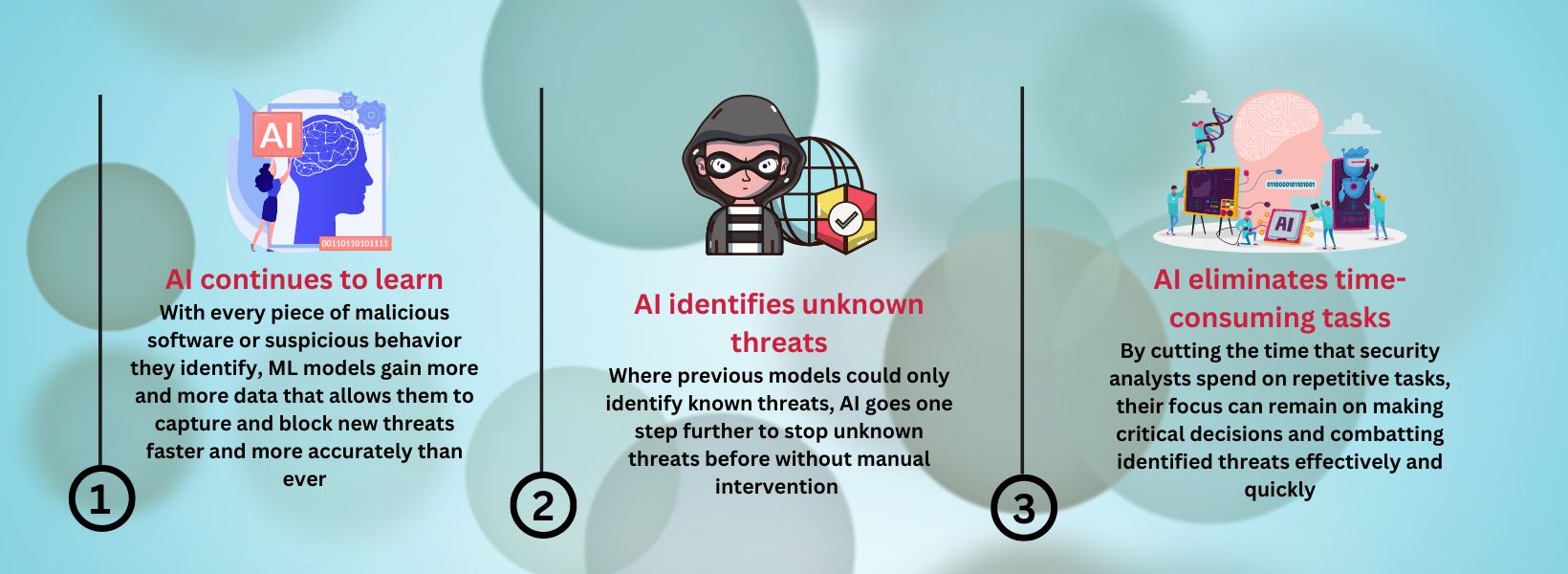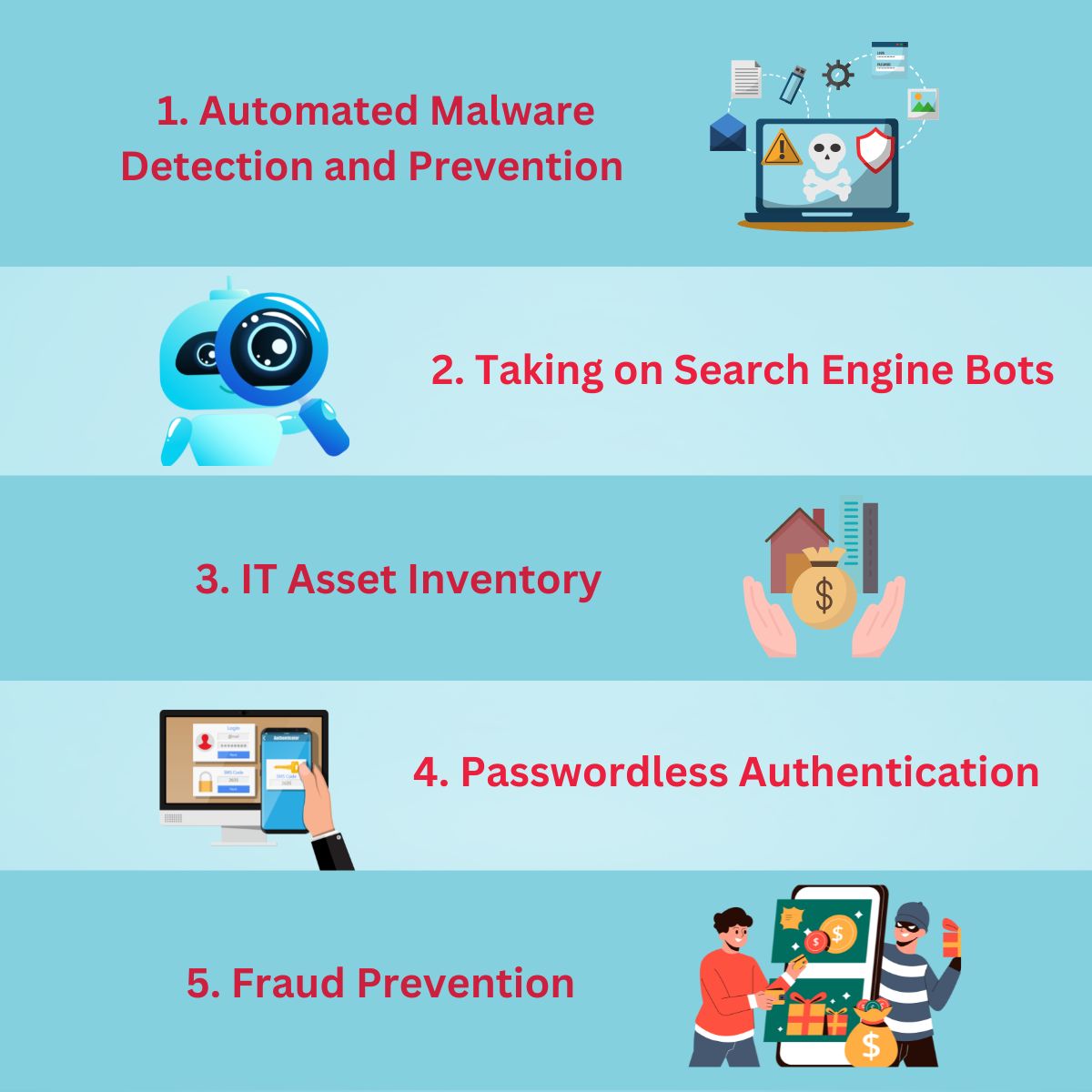
Artificial Intelligence in Cybersecurity – 5 Essential Applications You Need to Know
And cybersecurity is one of those areas that has gone through a huge shift.
While more advanced technology is allowing hackers to develop more intelligent means of breaching our online security, AI has augmented our means of protecting ourselves – as organizations and individuals.
Like physical security for our commercial buildings and homes, cybersecurity is protecting arguably our most valuable asset – our data.
After the onset of the Covid-19 pandemic pushed more businesses online, cyber threats have increased and become more complex in every area of cybersecurity: data leaks, phishing emails, malware, account takeovers, and more.
And as organizations grow and further develop their digital-first strategy, security online has never been more critical.
Back in 2013, an Adobe data breach allowed hackers to steal source code and a customer database that put 153 million of their customers at risk because the passwords were not stored under industry best practices – a prime example of the importance of maintaining the absolute highest level of cyber security to protect both your organization and your customers.
Which is where Artificial Intelligence comes into play.
AI Meets Cybersecurity – The Role of AI
AI models have the ability to process and analyze hundreds of thousands of data points in real-time to identify suspicious activity or malicious software – an impossible task for IT teams to undertake manually.

Applications of AI in Cybersecurity
The areas in which AI is augmenting and enhancing cybersecurity stretch from protecting individuals against email scams to managing the huge number of IT assets held by multinationals to keeping fraudsters out of our online accounts.
While the list of AI use cases in cybersecurity is already impressive in comparison to just a few short years ago, it’s just the tip of the iceberg in terms of its potential and is constantly evolving as new and exciting developments are made in the space.

1. Automated Malware Detection and Prevention
Every 11 seconds, a business falls victim to ransomware.
The pace at which hackers are creating new versions of malware that bypass signature-based detection is faster than ever, requiring more intelligent means of detecting and preventing malware threats.
Signature-based detection, although not without its merits, can only detect known threats.
Enter AI and ML (machine learning)-based tools that can detect unknown threats – by scanning software to search for characteristics, not signatures.
For example, software that tries to hide from detection or rapidly encrypt many files can be flagged as suspicious even if the software itself has never been seen by the tool before. The tools can also scan huge databases of existing malicious software and block an attack if a new, modified version of it surfaces.
Threats come from all angles, especially now that more and more employees are working remotely and customers are more frequently accessing systems or services online.
File-based malware, staff downloading personal apps, trying new software, and using free plug-ins all create security risks for enterprises that automated malware detection can combat in a way that human intervention by IT professionals cannot.
2. Taking on Search Engine Bots
For any enterprise, the performance of its website is crucial, and bots present a critical risk to that.
With 27.7% of global web traffic generated by ‘bad’ bots in 2021 – a greater number than in previous years – that threat is only increasing.
These threats are skewing the picture of the typical user journey, inflating website traffic, and presenting more severe threats like account hijacking, fake accounts, and data fraud. But they can’t be tackled manually.
ML models build an understanding of website traffic, determining whether it is an actual user, a ‘good’ bot like a search engine crawler, or a ‘bad’ bot that presents real threats to the organization.
This gives decision-makers the power to use this information to allocate resources towards preventing ‘bad’ bots from intruding on their systems or presenting a threat to their users.
3. IT Asset Inventory
Asset inventory management involves keeping an updated record of all the IT hardware and software within the enterprise. As this becomes the list of assets your security needs to protect, it’s the essential foundation for effective cybersecurity in any organization.
Inherently, this has been a very manual process for IT teams, allowing threats to slip through the cracks as the number of IT assets in any given organization grows year on year. And the larger a company is, it becomes exponentially more difficult to track inventory using manual methods such as spreadsheets.
Especially in large enterprises, assets are continually on the move:
- Old hardware is retired or upgraded to new models
- Users are added or removed
- New software is downloaded or updated regularly
That’s why the digital transformation in asset management being driven by AI is so crucial – to optimize asset usage and support the mitigation of cyber risks by knowing exactly what assets are in use and determining where potential threats are likely to come from.
4. Passwordless Authentication
90% of passwords are vulnerable to attack, which makes it unsurprising that 80% of data breaches are linked to weak passwords.
After all, with an average of 38.4 unique passwords to remember, the unsuspecting consumer might be tempted to use “Password2022” for easy remembering.
That’s why biometric authentication is an increasingly important part of any access management system, eliminating a huge portion of the security risk posed by using weak and repeated passwords.
Not to mention that this is often backed up with multi-factor authentication such as an OTP (one-time password) and standard passwords as a fallback if biometric authentication fails.
Unlike standard passwords – which are either entered correctly or incorrectly – no two captures of biometric data are identical. Thus, intelligent biometric systems make a ‘judgment’ as to whether the biometric data is ‘similar enough’ to the data captured when the individual enrolled. This can leave room for some small margin of error but cuts out the risk of hackers accessing accounts through lost or stolen passwords as biometric data is very difficult to hack or replicate.
Gartner anticipates that 60% of global enterprises will implement some kind of passwordless authentication method by the end of 2022. And the result won’t just be increased safety but an improved user experience driven by confidence and ease of login now that consumers don’t have to remember yet another password.
5. Fraud Prevention
No matter your industry, fraud prevention should be top of your list of crucial concerns for your organization.
In highly regulated sectors such as banking, this is already the case. Not only are banks under pressure to maintain regulatory compliance, but they possess arguably the most personal and damaging data about their customers were they to be part of a data breach.
That’s why implementing AI-enabled adaptive authentication methods driven by a wider digital transformation is so pivotal to ensuring the highest level of cybersecurity.
These fraud prevention solutions work by building purchaser profiles and models for ‘normal’ employee behavior to identify abnormal system behavior.
Fraud scores can then be assigned to transactions based on numerous data points. As transactions are made, the ML model monitors data such as the transaction amount, time, IP address, card use frequency, and much more in real-time to determine whether or not it fits the pattern of the customer profile or should be flagged as potential fraud.
Choosing the Right Security Partner
These security methods take specialist knowledge to implement and maintain.
If your organization needs an implementation partner to provide the highest level of security for your customers and employees, RediMinds’ dedicated team is committed to helping you make the right cybersecurity decisions.
Leave a few details and one of our security experts will be in touch for a free consultation about how we can support you.
